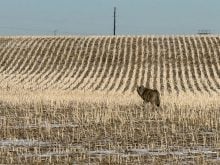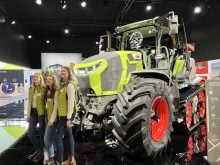REGINA – Canada doesn’t have hopping kangaroos, cuddly koalas or cranky crocodiles, but one Saskatchewan farmer discovered there are many things that make life on the Australian plains seem familiar.
Like their seasons, which are opposite to Canada’s, many conditions for farmers in Australia are the complete reverse of the good times prairie farmers are now enjoying, Ernest Andersen of Big Beaver said after returning from a visit.
“They’re going through exactly what we went through in the 1980s,” he said. “Guys are walking away from their farms – leaving them to the banks.”
Read Also

Agritechnica Day 2: The future of tractor power, building quicker crop apps and large farms and tech
Agritechnica Day 2: The future of tractor power, building quicker crop apps with Syngenta and large farms and tech
Andersen toured farms on both the east and west sides of Australia. While western farms have been affected by a three-year drought, their yields will probably be down only about 30 percent, he said.
But on the eastern side, bare fields and stunted crops attest to the much more crippling drought there. Some farmers haven’t bothered to seed this year and many of those that have, are left with no harvestable crop.
Andersen went to Australia to sell special equipment which makes it possible for a farmer to get some return from a drought-ravaged crop. He said vortex wind reels, which attach to combines, are “hot items” in Australia because they can harvest crops that are less than 60 centimetres (two feet) tall.
Canadian machinery is helping Australians get something from the crops they have been trying to raise, but Andersen said there is little drought advice one can give to the southern farmers other than “we’ve been through it and it will end.”
Andersen said the drought in the east and the size of the farms would be familiar to western Canadian producers, but farms in the west are quite different.
The sheer size of farms there – the average spread is 6,000 acres – is surprising to a Canadian producer, as is their harvest, he said. He visited a 20,000-acre farm where two brothers with two combines do all the harvesting. There is no frost so they can combine for up to two months, he said.
He was also intrigued by the size of Australian fields, which are 300 to 700 acres, and by the absence of fallow fields.
As a machinery salesman, he was also surprised to see machinery that doesn’t, as far as he knows, exist in North America. One piece in particular, a 12-metre (36-foot) rigid auger table on a combine, was larger than anything he had seen before.
He said North American machinery dealers insist no such machine exists, but he has photos to prove it, he said with a laugh.
Australia is a good market for North American farm machinery because the Australians import almost everything they use, he said.















